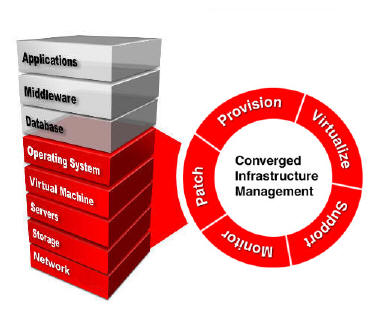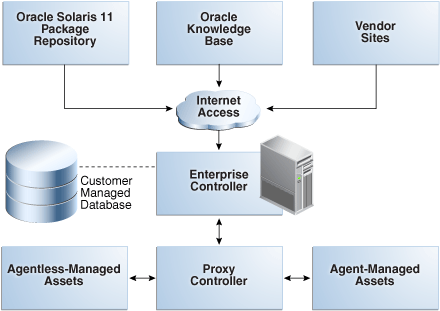1 Introduction
Many organizations are moving toward complex data centers that incorporate virtualization technology and disparate operating system, hardware, and storage device assets. System administrators are looking for effective methods for managing data center complexities, solving the major challenges that they face, reducing costs, and saving time. System management challenges include streamlining operations to control operation and maintenance costs, deploying new assets efficiently, responding quickly to changes in resources and reducing downtime. Oracle Enterprise Manager Cloud Control and Oracle Enterprise Manager Ops Center address these challenges.
This document provides an overview of the Oracle Enterprise Manager Ops Center software and explains its design. The following topics are covered in this document:
1.1 About Oracle Enterprise Manager
Oracle Enterprise Manager Cloud Control and Oracle Enterprise Manager Ops Center are complementary technologies that provide an enterprise-level data center management solution for all levels, from applications to storage disks. Each product monitors managed assets, or targets, but in different sections of the data center asset stack. Oracle Enterprise Manager Cloud Control manages applications, middleware, and databases, while Oracle Enterprise Manager Ops Center manages operating systems, virtual machines, servers, storage resources, and network resources. Together, they deliver a complete solution for data center infrastructure management. Figure 1-1 shows the three dimensional managed asset stack for Oracle Enterprise Manager Ops Center.
Install and configure the applications to work together, or use each application individually. This document focuses solely on the features and functionality of the Oracle Enterprise Manager Ops Center software.
1.2 Oracle Enterprise Manager Ops Center Solution
Oracle Enterprise Manager Ops Center is Oracle's comprehensive system management solution for managing the physical and virtual operating systems, servers, and storage devices in your data center. You use the discovery and management features to add your data center's assets to the set of managed assets in Oracle Enterprise Manager Ops Center. You can provision, update (patch), monitor, and manage the physical and virtual managed assets in multiple data centers from a single console, regardless of where the asset is located.
Figure 1-2 focusses on the assets managed by Oracle Enterprise Manager Ops Center.
Figure 1-2 Oracle Enterprise Manager Ops Center Solution

Description of "Figure 1-2 Oracle Enterprise Manager Ops Center Solution"
Oracle Enterprise Manager Ops Center is included in the Oracle Premier Support for Systems, Oracle Premier Support for Operating Systems, and Oracle Premier and Basic Support for Oracle Linux, Oracle VM Server for SPARC, and Oracle VM Servers for x86. By owning one of these Oracle Support contracts, you use and get support for Oracle Enterprise Manager Ops Center.
1.3 Key Features
The Oracle Enterprise Manager Ops Center software provides features tailored for administrating the data center infrastructure, including the following:
-
Dashboards: View a summary of a group of assets or an individual asset, including a graphical representations of the status and membership.
-
Incident management: Monitors the assets according to rules and thresholds that you set. If an incident occurs, the incident knowledge base is activated to display known issues and the assigned administrators in the Message Center. Add annotations to record actions and status or run scripts to resolve a known incident and solution.
-
Integration with Oracle Enterprise Manager Cloud Control: View configuration, health, and performance information and incidents of managed assets using either software product. Changes in one product are reported in the other product.
-
Profiles for assets: Creates software profiles and operational profiles that contain your custom executable scripts and include them in a plan.
-
Operational plans: Deploys a single script as an operational profile. An operational plan runs as an individual plan, or as a step within a deployment plan. Run the scripts independent of local software, and use them to perform specific tasks in your environment, such as configuration options, or to assist in incident management.
-
Deployment plans: Combines one or more profiles and scripts to create a multi-task plan that provisions operating systems or firmware efficiently and consistently.
-
Plan management: Provides default templates, profiles, and plans needed to create and deploy plans. Plan management also includes a Incidents Knowledge Base, where you can create a database of known issues. Use operational profiles and annotations to associate recommended or automated actions to respond to known issues.
-
Hardware management: Updates system component firmware and tracks hardware configuration changes over time. Increase energy efficiency by tracking energy utilization for ILOM x64, ILOM CMT, and M-Series servers and chassis and manages the power budget of ILOM 3.0 systems.
-
Virtualization management: Manages virtual assets such as Oracle Solaris Zones, Oracle VM Servers for SPARC, Oracle VM Servers for x86, and their guests. The network and storage resources for virtual assets are provided by their membership in server pools.
-
Reports: Creates reports for assets and activities and export the reports as files in PDF format or as comma-delimited values.
1.4 Architecture of the Solution
Oracle Enterprise Manager Ops Center is designed to provide increased scalability, high availability and optimized performance in large, distributed data centers. The architecture is scaled as your organization grows. The Enterprise Controller, Proxy Controller, Agent Controller, and user interface are the major architectural components, along with the Knowledge Base, that is hosted by Oracle Corporation and accessed through the Internet. This architecture lets you customize your deployment for the size and network topology of your organization by varying the placement of the Proxy Controllers and use of Agent Controllers.
In a basic deployment, information from the Knowledge Base and Package Repository is downloaded to the Enterprise Controller, which stores the information along with basic management tools, such as the profiles and plans. At least one Proxy Controller distributes the Enterprise Controller's work. Secure network connections between all components transfer control commands and data. For operating systems, Agent Controllers provide update capabilities, management and monitoring, and control of virtualization environments. Agent Controllers are required for Linux and Oracle Solaris update jobs, system catalogs, update reports, and operating system provisioning. Oracle Solaris 9 and Oracle Solaris 10 boot environment management also requires an agent-managed operating system. Agent Controllers are not required for updating Microsoft Windows systems.
Figure 1-3 shows the basic deployment of architecture of Oracle Enterprise Manager Ops Center.
Figure 1-3 Basic Deployment of Architecture of Oracle Enterprise Manager Ops Center

Description of "Figure 1-3 Basic Deployment of Architecture of Oracle Enterprise Manager Ops Center"
1.4.1 Knowledge Base and Package Repository
The Knowledge Base and Oracle Solaris 11 Package Repository store metadata about Oracle Solaris and Linux operating system components. The metadata includes patch dependencies, standard patch compatibilities, withdrawn patches, and rules for download and deployment. The Knowledge Base keeps track of the URLs for the operating systems and retrieve the components from the appropriate vendor download site.
By default, Oracle Enterprise Manager Ops Center is configured to connect to Oracle Corporation sites for updated metadata for operating systems. However, you can configure the product software without a direct connection to these sites.
1.4.2 Enterprise Controller
The Enterprise Controller is the central server for Oracle Enterprise Manager Ops Center. All operations, or jobs, are initiated from the Enterprise Controller. Enterprise Controller manages firmware and operating system images, plans, profiles, and policies. The Enterprise Controller relies on a database of asset data and site customizations. The database is a local embedded database or a remote Oracle Enterprise Edition database that is accessible on the network to the Enterprise Controller. Include the Enterprise Controller in an active-standby High Availability configuration to increase the availability of the Oracle Enterprise Manager Ops Center software.
The Enterprise Controller connects to the Internet to get access to contract information, to create service requests, and to download updates, Oracle Solaris images, and updates to the product software itself. When an update is requested, the Enterprise Controller retrieves the software from the Knowledge Base, package repository, or vendor. This default mode of operation is called Connected mode.
If your site policy does not permits an Internet connection, you can operate the software in Disconnected mode. In this mode, you must load and maintain the Knowledge Base and package repository data and updates in the Enterprise Controller. For Oracle Solaris and Oracle Linux operating systems, Oracle Enterprise Manager Ops Center provides a script that you run on a system that is connected to the Internet to retrieve the contents of Oracle's KB and then you upload the baselines and updates to the Enterprise Controller. For all other supported operating systems, you obtain the updates in a media format, such as a CD or DVD, and upload the information as local content.
1.4.3 Proxy Controller
Proxy Controllers distribute the operation load and provides for fan-out capabilities to minimize network load. The Proxy Controller can also be used to provide a network presence behind a firewall or to provide access to a private network. A Proxy Controller links the managed assets to the Enterprise Controller and performs operations that must be located close to the managed assets, such as operating system provisioning. Proxy Controller performs management operations on agentless assets and reports the results to the Enterprise Controller. The actions required to manage, provision, and update assets are handled as a queue of jobs.
You must have at least one Proxy Controller. You can have a co-located Proxy Controller, that is, the Proxy Controller and Enterprise Controller software are installed on the same system. To enhance performance and scalability, the preferred method is to install the Proxy Controller on a separate machines.
Figure 1-4 is a diagram of a Co-located Proxy Controller.
Although this architecture deploys a working Oracle Enterprise Manager Ops Center solution, most sites benefit from using multiple Proxy Controllers because of the following conditions:
-
The data center has multiple assets to manage.
-
Some assets are in remote locations and you want to maintain performance.
-
You anticipate creating multiple jobs to run concurrently.
-
Some assets are behind a firewall and need their own Proxy Controller.
-
Some assets are on their own subnets and need a Proxy Controller on the same subnet for operating system provisioning.
In Figure 1-5, one Proxy Controller is designated for the Management Network and another Proxy Controller is for the Data Network. The illustration shows how you associate one Proxy Controller with the managed Service Processors and associate another Proxy Controller with the operating systems.
1.4.4 Agent Controllers
Physical and virtual Oracle Solaris and Oracle Linux operating systems require agent software to perform many functions, such as creating update reports, creating and using system catalogs, and managing Oracle Solaris 9 and Oracle Solaris 10 boot environments. Some monitoring and Analytics data also require an agent-managed operating system. However, you can use many of the monitoring and management features without installing an Agent Controller on the operating system.
The Agent Controller is a lightweight Java software that identifies the asset and responds to a Proxy Controller. When an operating system is agent-managed, the agent receives the command from its Proxy Controller, performs the required action, and notifies the Proxy Controller of the results. When an operating system is agentlessly managed, the Proxy Controller uses SSH (Secure Shell protocol) to perform tasks and to monitor the operating system.You can change the method of managing an operating system asset.
Hardware management does not require the Agent Controller. Instead, a Proxy Controller runs commands on the hardware system and reports the results to the Enterprise Controller.


